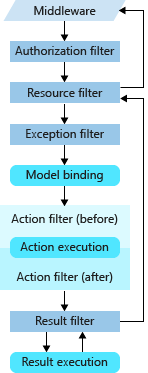The support for ActionFilters in ASP.NET MVC and Web Api gives you a nice execution pipeline to run code before or after specific stages in the request processing pipeline:

They are a great fit for a lot of use cases, like validation, caching, … and allow you to have an AOP like approach in your controllers. Their are 2 things I find annoying about the usage of ActionFilters:
- They introduce an extra layer of abstraction with some hidden magic. It is not always clear what’s going on the request pipeline and what happened in a specific filter.
- It is not easy to share state between your action filter and your controller (which can be useful sometimes).
Recently I discovered a great trick that solves the problems above.
Did you know that a controller is also a filter – as it implements both IActionFilter and IAsyncActionFilter interfaces, you can override the related methods and turn your controller into an action filter?